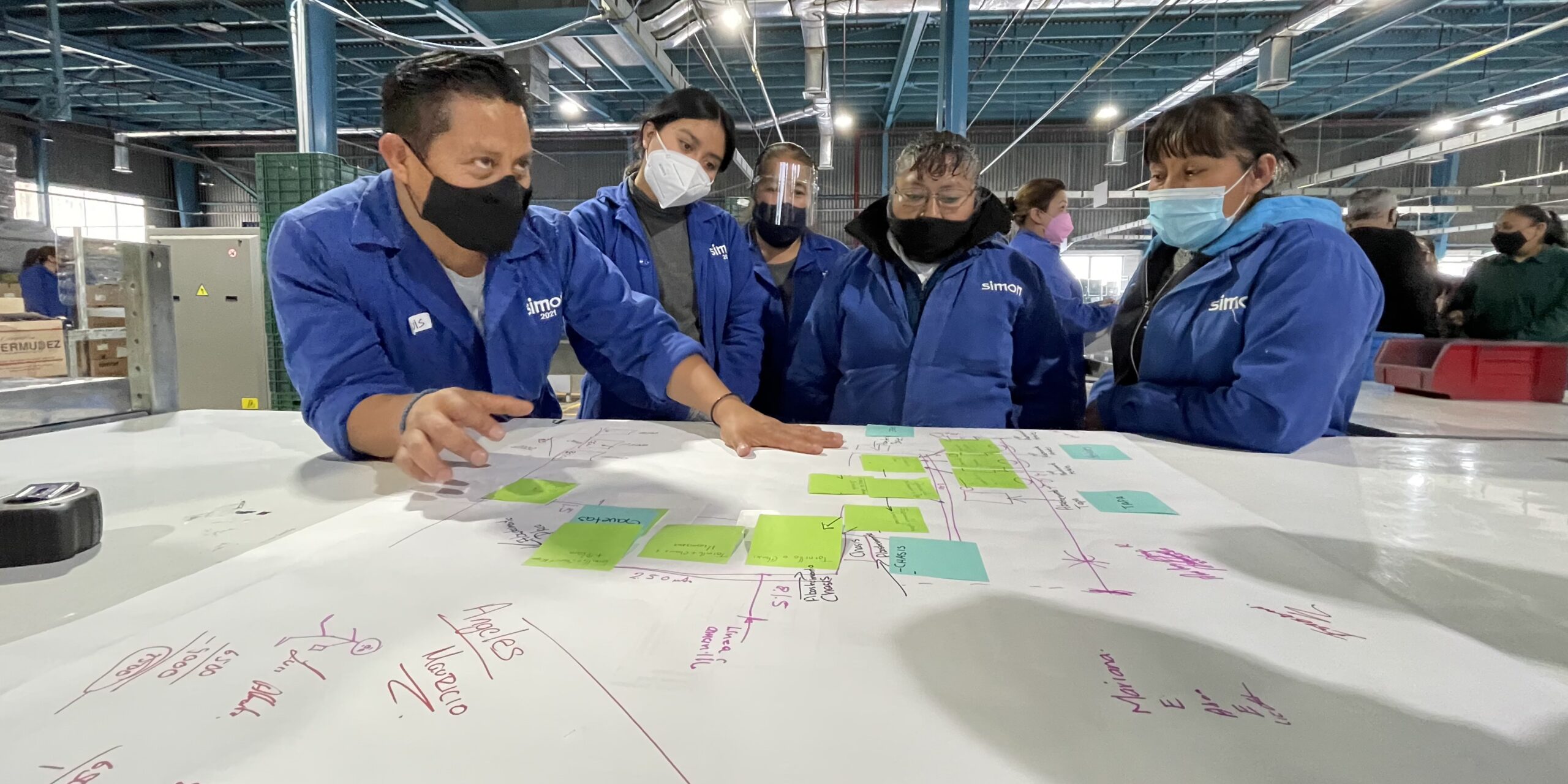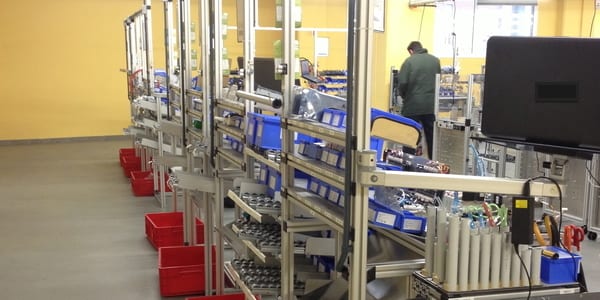
Transforming quickly, but mindfully
CASE STUDY – Starting in January this year, the Mexican plant of this manufacturer of lighting and electrical solutions has initiated a lean transformation that has already led to impressive results in terms of productivity.
Words: Mauricio Rodríguez, Operations Director, Simon’s plant in Toluca, with Héctor Rincón Ortiz, lean coach at Lean Institute Colombia.
Change has been fast at the Simon plant in Toluca, Mexico, where in a few short months, we have paved the way for a complete turnaround.
Our reason for turning to Lean Thinking in the first place was the big drop in productivity we experienced during the Covid-19 pandemic, coupled with the large volume of orders we had to fulfil. Lean is not new in the Simon Group. The HQ in Barcelona, Spain already has quite a bit of experience with it, but for us it was all new.
We began this journey in January, when Lean Institute Colombia came in to run a diagnostic of our processes. It quickly became clear that ours would be a cultural turnaround that would solidify our use of standards and indicators and change mindsets across the organization. Through lean, we hoped to get more control of our work and improve the overall performance of the plant.
Following the diagnostic, we began to run kaizens across our manufacturing operations – gradually reaching other areas of the business, those whose work is more closely tied to production. Among the results we achieved on our lines from those seven initial kaizens, there are: an increase in OTD (on-time delivery) from 50% to 85%, with a plan to reach 95% by the end of the year; a 25% increase in productivity/operator; a reduction in change-over times from four days to one day with the removal of in-process inventory (WIP); a considerable boost to our ability to fulfil orders (products go to the delivery area straight from the line three times a day).
We are using lean techniques and practices across the plant. We have created a skills matrix, for example, for a better approach to people development, and we are relying heavily on daily meetings to keep communication flowing among people and stay on top on any problems that might arise. This goes hand in hand with our reliance on indicators: we have a “KPI room” these days (it’s not as Obeya yet, especially because it doesn’t look at the overall business but only at Operations), where detailed indicators are used to track our progress and keep an eye on the work. By walking in, anyone can understand the state of things with a quick glance.
Supporting our kaizen efforts, we also have people from purchasing, invoicing, customer care, etc. This helps people in manufacturing because it brings in the fresh, useful perspective of others involved in the provision of value to customers, while also shedding a light on the synergies that exist between departments. This is likely behind the expansion of lean to other areas of the business, from Human Resources to Sales.
Thanks to these improvements, the Toluca plant has achieved control of its lines, making a lot of progress towards built-in quality ad empowering people to own their processes. We have learned to do more with less and have more control of the work (especially with regards to inventory levels). All of this has led to the great productivity boost we have experienced.
DEVELOPING CHANGE AGENTS, TRANSFORMING LEADERSHIP
Our development program, devised by Lean Institute Colombia, consisted of providing training on Lean Thinking to a diverse group of people. They are now responsible for sharing knowledge and lean practices with the rest of the team at the front line. Because of their new role as change agents and ambassadors of the methodology, people are seeing a new attitude in their leaders, which makes the transition to lean easier.
Of course, not everyone has interiorized lean lessons easily or quickly. Some people struggled at first, mainly because they didn’t believe that change could come that fast. Today, these folks are great supporters, and if we have been able to change their minds is because we could show them quick wins and results that helped both the business and operators in their daily lives. There is nothing more effective in getting people to understand the importance of thinking lean.
For a lean transformation to succeed, however, it is not enough to have buy-in from people at the front line. In fact, the biggest obstacle to a successful turnaround is typically leadership. Because we are conscious of this problem, we are trying to engage other Directors and the General Director in the transformation. They have been aware and supportive of it from the very beginning and understand that change doesn’t come from one day to the next. I myself have changed my leadership style considerably: I am much more present at the gemba than before and strive to be available to answer people’s questions and help them in their problem-solving efforts. As I see it, this gives them great confidence and makes them much more committed to the lean transformation.
There is no doubt that our plant’s journey is happening very quickly. We are taking big steps, but we are doing so consciously. There is certainly a sense of urgency in the air, but we also want to do things well – which requires helping people to understand “why” we are trying to change the way we do things. Our emphasis is still on experimentation. We understand that the kaizen improvements we have made are just a first step. We learn new things every day and we will continue to engage people in updating standards and making improvements.
WORKING AS A PILOT PROJECT
As we look ahead at our next steps, we want to consolidate the improvements we have initiated with value stream mapping, extend the reach of daily management to our workshop, and introduce other key tools to gain productivity. In our future, we see a complete business system in the Toluca plant, one in which people are increasingly comfortable flagging up problems and autonomous in solving them.
Our efforts are being noticed across the Simon group at an interesting time, as HQ is busy developing the Simon Production System. With the lessons we learned and the solid practices we are developing, our plant can act as a pilot project and, at a later stage, as a coach for other sites in the group that might wish to start a lean transformation. I believe we are going to be a great example, in particular, for those plants that – like us – have a lot of semi-automatic and manual work (as opposed to more tech-heavy sites in the group). We have a lot to learn, but also much to teach others.
We have already seen what big contribution lean can give in terms of cost reduction, productivity increase, and – perhaps more importantly – in inventory control, thus limiting the amount of money one has tied up in their plant and better connecting with customer needs. To have a system that allows you to control costs and keep prices lower than your competitors seems particularly critical today, with soaring costs threatening the bottom lines of businesses all around the world.
Calling all Spanish-speaking lean thinkers, learn more about lean at the upcoming Lean Summit Colombia!

THE AUTHORS


Read more


FEATURE - It took a Spanish clinical diagnostics instruments manufacturer the introduction of a new product to realize how an old-fashioned system and management style were preventing the company from thriving.


OPINION – The latest banking scandal had us all wonder whether Wells Fargo has lost its way. But how does a pioneering bank that once had lean at its heart betray its core values so profoundly?


FEATURE – This article explores the concept of “value network”, emphasizing the importance of looking at lead-times and value creation in a more holistic way.


ARTICLE - What is lean? We all like to think that we know. This personal story reminds us all of how elusive the methodology can be, and how determined a practitioner has to be to fully grasp it.

